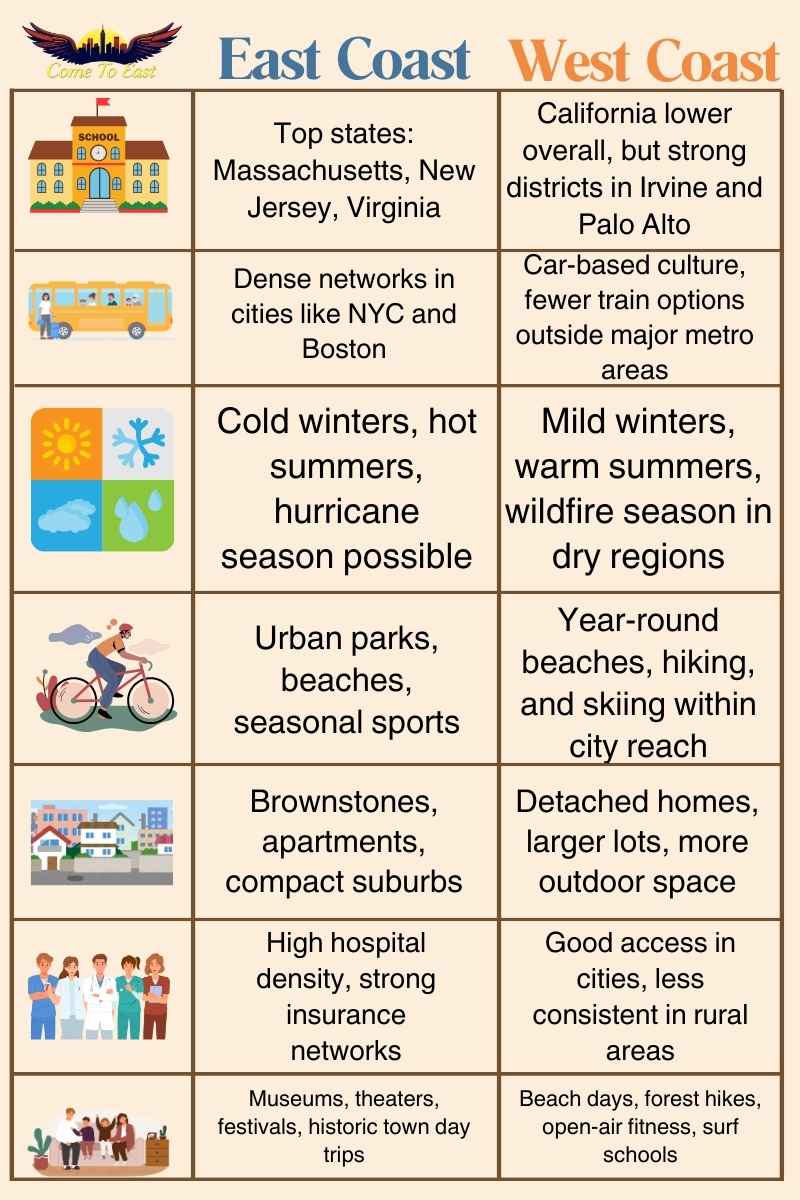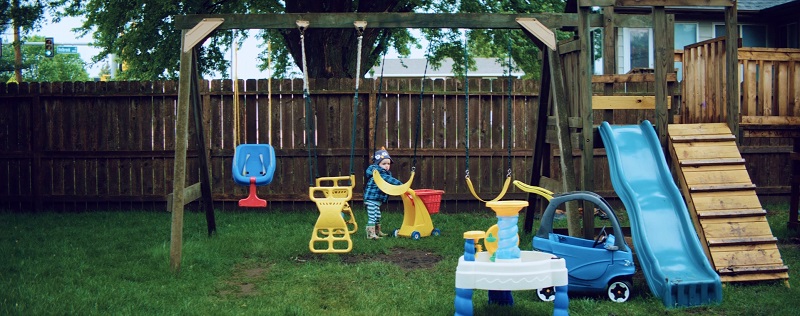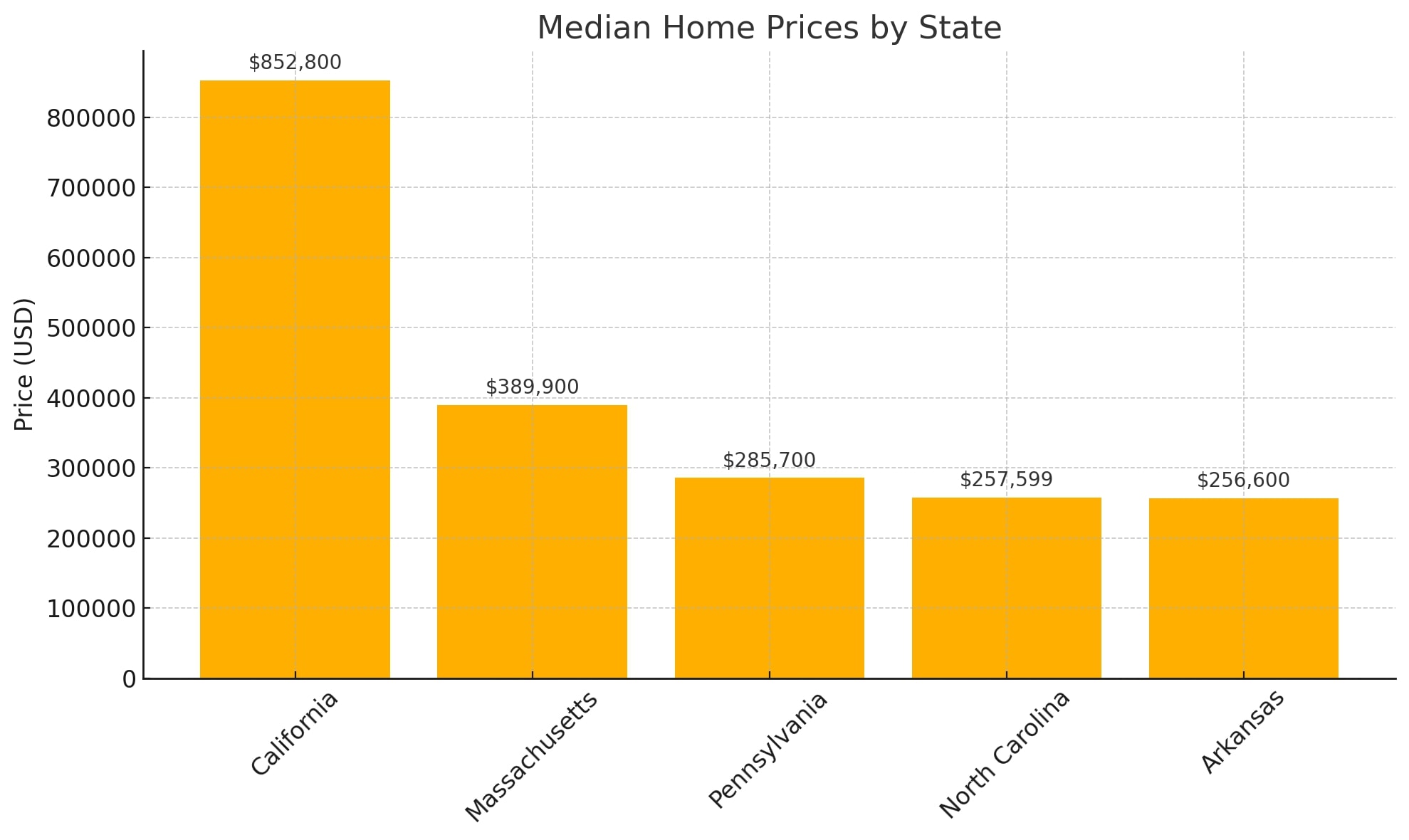East Coast and West Coast offer two very different environments for raising a family. East Coast includes cities such as Boston, New York, and Philadelphia. These areas support strong public transportation systems, access to top-ranked schools, and a deep concentration of historical and cultural institutions. Many families benefit from structured urban programs, year-round educational events, and strong academic expectations.
West Coast regions include California, Oregon, and Washington. These states focus on outdoor accessibility, coastal living, and open landscapes. Families in West Coast cities often spend more time in nature, with access to beaches, trails, and national parks. Communities often encourage relaxed schedules, flexible schooling models, and health-conscious lifestyles.
Cultural expectations, pace of life, climate, and available support services vary across each coast. Parents who prioritize academic structure and public resources may lean toward the East Coast. Those who prefer open environments and nature-based recreation may prefer the West Coast. Real differences in cost, safety, education, and infrastructure define how well each coast supports family life.
Which Coast Offers the Right Life for Families?
Parents need more than a climate preference. Family success depends on school access, safety, job support, and how a neighborhood supports child development. Each coast delivers a different environment, both socially and practically. Location will shape the way children grow up and how families manage daily life.
Real Differences Between East and West Coast Life

Facts come from state school performance rankings, climate data, urban planning surveys, and family health reports.
What East Coast Families Value Most
Families in cities like Boston, New York, and Philadelphia often live close to museums, concert halls, and historic centers. Children visit institutions like the Boston Children’s Museum or the Smithsonian before age six. Public schools in counties such as Montgomery in Maryland or Bergen in New Jersey consistently rank in the national top ten.
Most East Coast suburbs offer short train rides into job centers. This allows one parent to work in the city while the other manages school routines in a calmer area. Families value structure, fast-paced schedules, academic preparation, and deep cultural exposure. Extra activities often include private music lessons, STEM camps, and regional sports leagues.
Why West Coast Families Feel More Relaxed
West Coast cities such as San Diego, Portland, and San Jose support more relaxed, outdoor-centered family habits. After school, children hike with their parents, attend beach fitness programs, or learn hands-on gardening in public charter schools. Neighborhoods include more private space, fewer vertical developments, and better air in areas like Marin County or Santa Barbara.
Families spend more time outside due to mild temperatures year-round. Programs in cities like Seattle or Santa Monica include youth surfing, community yoga, and family biking clubs. School calendars may include extra outdoor labs, trail studies, and local agriculture units. Emotional wellness and work-life balance receive more focus than test scores.
Which One Fits Your Family Best?

Parents who want strict academic progress, strong test prep, and deep historical access may find the East Coast a better fit. Family life focuses on achievement, tradition, and high standards. Public systems are well-established and supported by structured transit.
Families who want easy access to nature, low-stress routines, and health-focused living often prefer the West Coast. Children benefit from more sun, cleaner air in rural zones, and unstructured creative learning in many school systems. Less commuting, more space, and outdoor culture shape how families spend time together.
How Cost of Living Shapes Family Life on Each Coast
Parents calculate more than weather or school rankings when planning a move. Real daily costs can define how much time families spend together, how far their income stretches, and what level of comfort they can maintain. Housing, childcare, groceries, and transportation costs vary widely by region.
Home Prices Tell the First Story
West Coast and East Coast both contain high-cost zones, but patterns differ. On the West Coast, the median home price in California reaches $852,800. Coastal cities like San Francisco, San Diego, and Los Angeles drive this number. In contrast, East Coast pricing depends more on state and proximity to major cities.
Some families consider Massachusetts the Northeast benchmark for housing prices. Median home values there now hover around $389,900. Urban cores such as Boston cost much more, though outlying towns offer slight relief. Mid-Atlantic states like Pennsylvania remain more affordable by comparison.

Urban homebuyers on either coast face stiff competition and high down payments. Suburban families often seek better value in towns like Sacramento, CA or Allentown, PA. Decisions often balance commute time, school district quality, and housing cost.
Daily Expenses Create Long-Term Impact
East Coast families in cities like Boston or New York face steeper grocery costs, daycare fees, and transportation bills. Massachusetts families pay about $16,781 annually for childcare. Public transportation reduces car expenses, but food and housing costs stretch middle-income budgets.
On the West Coast, costs depend on location. Living in coastal California brings premium pricing on food, insurance, and services. Inland cities such as Fresno or Eugene offer relief. Washington and Oregon maintain moderate pricing in suburban regions while delivering strong family services.
Utility prices, gas costs, and school fees all contribute to monthly planning. Parents often adjust their lifestyle by choosing between shorter commutes or cheaper homes farther out.
Resource Access Changes the Equation
East Coast cities offer dense networks of healthcare providers, public libraries, museums, and after-school programs. These resources benefit families with academic goals or structured recreational needs. Cities like Philadelphia, Washington DC, and Boston include hundreds of free or low-cost learning centers.
On the West Coast, the landscape changes. Cities build around nature. Outdoor parks, public beaches, and recreational zones dominate weekend schedules. Access to year-round sun in Southern California lets families spend less on indoor entertainment. Portland and Seattle blend public libraries with nature-based education, offering another balance point.
What Families Must Weigh
Families on the East Coast gain access to world-class public services, strong school districts, and career hubs. The price is higher rent, stricter zoning, and longer waitlists for childcare. West Coast families enjoy more outdoor flexibility, better weather, and wide-open neighborhoods, but face high home prices in California’s core areas.
Budget matters. Access to family programs matters. So does commute time, local school strength, and space for children to grow. Each region supports different lifestyle needs. Parents must weigh cost, convenience, and quality together.
How Climate Shapes Daily Life and Family Time
Every family experiences weather in a different way. Some enjoy four clear seasons with changing scenery. Others prefer stability, with sunny skies and outdoor access all year. Climate shapes the rhythm of a child’s routine, from school drop-offs to weekend bonding.
Weather affects how often families leave the house, what types of sports or clubs they join, and how predictable their schedules stay. Storm delays, snow days, heat warnings, and wildfire seasons all enter into the picture.

A Calendar of Experiences: East Coast Seasons
Fall on the East Coast sets the tone for weekend activities. Apple picking, corn mazes, and foliage drives fill family calendars between September and November. Parents in upstate New York, New England, and Pennsylvania plan hikes around peak leaf color.
When winter hits, skiing takes over in Vermont, New Hampshire, and parts of Maryland. Children learn snowboarding or sledding before the new year. Ice skating becomes a weekend staple in city parks and frozen lakes.
Spring brings cherry blossoms to Washington DC, floral festivals in New Jersey, and nature walks in North Carolina. As temperatures rise, picnic zones reopen and school trips focus on botanical gardens or science centers.
By summer, the coastlines draw full crowds. Cape Cod, the Jersey Shore, and parts of coastal Virginia support day trips or weeklong rentals. Parents swim with their children, take ferry rides, or try family kayaking.
Each season reshapes how kids spend time outside. Schedules adjust to accommodate climate swings. Some families enjoy the variety, while others prefer consistency.
What West Coast Families Get Every Month
Parents living in Southern California or coastal Oregon do not wait for spring to enjoy the outdoors. Surf lessons, beachfront cycling, and playground picnics happen all year. Even January can mean a morning at the beach and an afternoon hike inland.
Children in Northern California and parts of Washington take nature-based classes through forest school programs. These run uninterrupted for months. Rain may come, but snow rarely halts activity in cities like San Jose or Santa Cruz.
Outdoor events such as sunset concerts, stargazing nights, and year-round soccer leagues define family culture. Most communities hold monthly beach cleanups or nature hikes. These reinforce both bonding and physical health.
Mild temperatures also change routines. Kids can bike to school in March, eat lunch outdoors in December, and attend after-school events in local parks well into fall. The predictability of weather allows long-term planning without weather cancellations.
What the Weather Feels Like on Each Coast
Weather plays a huge role in how families plan each day. Some parents want four seasons. Others prefer sun and comfort all year.
On the East Coast, families get hot summers, cold winters, and everything in between. July in New York or Virginia brings humidity, heat, and strong sun. January turns icy, especially in places like Boston or upstate Pennsylvania. Snow piles up. Roads freeze. Parents spend mornings shoveling or checking school closures. Spring comes with rain and mud. Fall feels crisp and colorful, with cooler air and clear skies.
That rhythm means wardrobes change every few months. Heating bills rise in winter. Air conditioners work hard in summer. Families plan vacations, school breaks, and even birthday parties around the forecast.
The West Coast stays more stable. In Southern California, most days feel the same: mild, sunny, and dry. Cities like San Diego or Santa Barbara rarely see snow. Kids wear short sleeves in February. Rain is rare, especially in summer. In the north, places like Seattle or Portland get cooler temperatures and more cloudy days. Rain shows up more often but snow stays limited.
Best East Coast Cities and Suburbs for Raising a Family
Not all locations offer the same quality of life for families. On the East Coast, certain cities stand out for education, safety, outdoor access, and long-term stability. Rankings reflect national data on public services, school scores, and crime rates. The cities listed below consistently perform well in those areas.
| City | National Rank | Why Families Choose It |
|---|---|---|
| Charleston, SC | 14th | Strong public schools, active community, historic setting |
| Virginia Beach, VA | 18th | Clean beaches, local parks, family programs, safer suburbs |
| Columbia, MD | 21st | High-ranking schools, green spaces, well-planned layout |
| Chesapeake, VA | 23rd | Balanced housing, stable neighborhoods, consistent amenities |
Charleston offers a mix of culture, education, and local support. Virginia Beach draws families looking for outdoor access without losing structure. Columbia focuses on safety, order, and top-tier schools. Chesapeake serves parents looking for long-term comfort and reliable city services.
Conclusion
Choosing between the East Coast and West Coast for raising a family means weighing real differences. School systems, housing costs, safety levels, healthcare access, weather, and day-to-day routines all shift depending on region. Some families need strong public education and structured environments. Others want space, sunlight, and daily time outdoors.
The East Coast supports tradition, dense culture, and academic opportunity. Public transportation makes cities easier to manage. Winters get cold, but resources stay close. The West Coast offers nature, modern infrastructure, and flexibility. Families live farther apart but gain year-round access to beaches, parks, and open air.
No coast is perfect. Every family brings different needs, budgets, and expectations. The best choice comes down to where your values match the environment around you.

